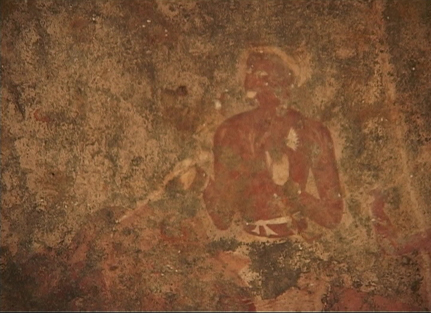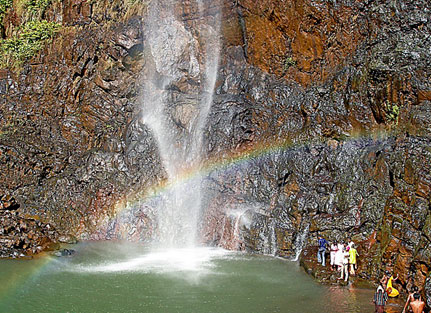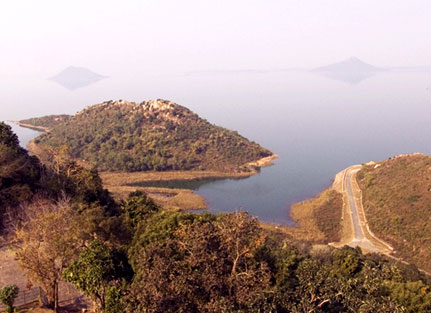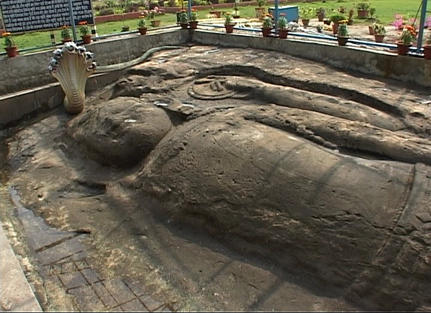Bargarh and Sonepur among the 20 pilot Handloom Clusters of India
Bargarh, Bargarh, Cottage industry and Handlooms, Handloom Clusters, MSE - medium and small enterprises, Rural artisan villages, Sambalpuri Sarees, Sambaplur- Burla- Bargarh- Chipilima, Sonepur, Sonepur Comments Off on Bargarh and Sonepur among the 20 pilot Handloom Clusters of India(Thanks to http://kddf.wordpress.com/2009/12/02/information-about-subarnapur-district-handloom-cluster/ for the inspiration to write about this.)
The following is from the pages http://www.indianhandloomscluster-dchl.net/index.asp.
The overall handloom situation in Orissa is as per the following table:
|
DISTRICT WISE CLASSIFICATION OF HANDLOOMS AS PER CENSUS 1995-96 |
||||||
|
No. of Looms |
Up to 1000 |
1000-5000 |
5,000 – 10,000 |
10,000-25,000 |
25,000 – 50,000 |
Above 50,000 |
|
|
1 |
2 |
3 |
4 |
5 |
6 |
|
STATE : ORISSA |
||||||
|
|
Deogarh |
Angul |
Bolangir |
Bargarh |
|
|
|
|
Gajapati |
Bhadrak |
Cuttack |
|
|
|
|
|
Jharsuguda |
Dhenkanal |
Ganjam |
|
|
|
|
|
Keraput |
Kendrapara |
Nayagarh |
|
|
|
|
|
Malkanagiri |
Keenjhar |
Sonepur |
|
|
|
|
|
Nawarangapur |
Nuapara |
|
|
|
|
|
|
Phulbani |
Puri |
|
|
|
|
|
|
Rayagada |
Sambalpur |
|
|
|
|
|
|
Sundargarh |
Kalahandi |
|
|
|
|
|
|
|
Balasera |
|
|
|
|
|
|
|
Boudh |
|
|
|
|
|
|
|
Jagatsinghpur |
|
|
|
|
|
|
|
Jajpur |
|
|
|
|
|
|
|
Mayurbhanj |
|
|
|
|
|
|
|
Khurda |
|
|
|
|
|
|
9 |
15 |
5 |
1 |
30
|
|
Among those, Bargarh and Sonepur are among the 20 pilot clusters.
The page for the Baragarh cluster is http://www.indianhandloomscluster-dchl.net/Bargarh/Index.asp. Following is some information from that page.
Bargarh Handloom cluster is spread over the entire Block of Bargarh, Attabira, Bijepur and Sohella. The cluster has 7158 numbers of looms as per the survey report of the zonal Handloom office taken up during the year 2004 out of which 5102 looms are working in 299 different villages. The main products of the cluster are cotton sarees of tie and dye and small amount of dress materials, lungis and napkins etc. The annual production is around 10 Crores rupees. The products of this area are mostly marketed in Orissa and National market. The cluster so to say represents Orissa in quantitative and qualitative Tie and Dye Cotton Sarees as no other clusters of other districts in Orissa produces such sarees.
… The weaving in the cluster by the traditional weavers’ community popularly known as "Bhulia" came in to existence during mid of 17th century and with increase in their population, they spread to other nearby places. They initially belong to Rajasthan and were presented during the 14th century to the ruler of Patna State, a king of Chouhan dynasty "Ramai Deb". Later on they were presented to the king of Sonepur during the 16th century and scattered to the nearby district i.e., Bargarh in the next century.
The cluster consists sizable number of professional weavers (Non traditional) from Schedule Caste and Schedule Tribe (Kuli caste) weavers, which in total accounts for 60 %. Generally these weavers are less skilled and engaged in production of Napkin, Lungi, Sarees, Dhotis, etc.
Weaving with Tie dye in the cluster prior to 40”s was done with 40”/42” looms operated with hanging slay and engaged in producing Kapta, Lungi and Napkins made of 12’s/16’s/20’s cotton yarn. The yarns were dyed with vegetable colours. The main colours were Yellow (from Turmeric), Maroon (From bark of Aal tree), Blue form Nile and Black (From Hirakasi and Chakda Seeds). Fabrics of vegetable colours were sometimes not fast and ranges of colours were also limited, forcing the Tie-Dye production in to limited colours and so also the design. Such practice was on vogue till the mid of 40s when vat colour was first substituted for in place of some vegetable colours.
The next major changes in the cluster took place with the introduction of twisted cotton mercerized yarn and synthetic colours in the early 60’s. The looms started widening mainly to 52" width for normal sarees and other production and 90" for double bed sheet production. There were also few 60” / 72" looms to accommodate weaving of middle-sized bed sheets.
Activities in the cluster started taking momentum with the involvement of Late Padmashree Dr. Krutartha Acharya and his four associates in the cluster area during 1942 and started their business with production on limited numbers of looms. Later he converted his business in to a co operative society named Sambalpuri Bastralaya, registered during the year 1954 under "Bihar and Orissa Co operative Societies Act" and established in Bargarh town. This is the first firm in the cluster, which took the leadership in weaving activities of cluster and stood as a milestone in its history.
… Unlike the Tie-Dye work of other states of India, the motif and designs of the cluster are infinite in number and every motif or design is categorized under a special caption. No design is let out without giving it a name. It shows the creative mind of the weavers of the region.
The page for the Sonepur cluster is http://www.indianhandloomscluster-dchl.net/Sonepur/Index.asp. Following is some information from that page.
The writing in the stones of Kahandagiri cave Orissa suggests that the art of weaving was in Orissa before 600 B.C. Similarly some carving in the temples of Sonepur cluster (Baidyanath) indicates that weaving was in existence in the area during prior to 9th B.C. Besides weaving with cotton yarn, there was also weaving with wild silk (Tassar), wool and fibers from stem of lotus. The tie-dye weaving in western Orissa came in to existence during mid of 14th century when 100 weaver’s families were brought from Raipur area of Madhya Pradesh by the then ruler of Patnagarh Sri Ramai Dev. The weavers’ later on titled as Meher and their caste known as Bhulia. Such weavers were traditionally weaving the tie and dye fabrics. Orissa has also history of exporting handloom to south-east Asia countries like Thailand, Java, Borrneo and Sumatra (Last three are Island of Indonesia) during pre-independence period in sea route. It is therefore also the bank of river Mahanadi and some other big river of Orissa has developed weaving culture.
The Bomkai Designs are the traditional designs in production in the village named Bomkai in Ganjam District of Orissa. Latter on it is introduced in Sonepur. Before 1950’s the main product mix of this cluster was cotton sari and Dhotis. The main occupation of "Bhulia" community was weavings. Weavers had looms of short width and they used to weave cotton sari of length 12ft and its width was 36 inches. During that period, cotton yarn of (10 to 40) counts were available in the market.
Weavers by own used to sell woven sari at nearby locally market and whatever they got remuneration by selling the sari, they used to brought yarn for further weaving. During this period, due to absence of chemical dyes, mainly vegetable dye was used to dye the yarn. Vegetable dye had limited colours i,e yellow (From Turmeric), Maroon (From bark of Aal trees), Blue (Nile) and black (Hirakasi and Chakda seeds). The colour of vegetable dyes was not fast in the fabrics. The vegetable dye has limited ranges of colour that limit the design of tie & dye fabrics. During mid of 1950’s the late Padamshree Sri Kruthartha Acharya was the up-coming entrepreneur in handloom sector. He was belonging to Bargarh sub-division which was neighbouring district of Sonepur. He had installed 200 looms at Sonepur and established a unit for producing handloom sarees. During mid of 1960’s, lots of modifications were done to upgrade the handloom sector of Sonepur. The widths of looms were widening up to (48 to 50) inches; mercerized yarns of finer quality (60 counts) were introduced. Shri Kruthartha Acharya also introduced chemical dyes. Many weavers were trained to adopt the change. Due to introduction of chemical dye, the ranges of colour shed were increased which helps the weavers to produce variety of design in tie and dye fabrics. Slowly other weavers of the cluster adopted the new technology. Dr Acharya also searched other market by promoting the Sonepur product in other States by participating in exhibition and fair conducted by handloom department, Govt. of India. He also used to purchase the woven sari from weaver and used to supply raw materials and design to them. This helped the weavers to only concentrate on production work instead of marketing the products. Latter on during 1954, Dr. Achaya converted his firm into cooperative society named Sambalpuri Bastrayala Handloom Cooperative Society Ltd, Bargarh, which is at present stand as a leading PWCS of not only the State but also of the country. During mid Seventies G.O.O. initiated a corporation called Orissa Handloom Development Corporation which grew and decayed in two decades and has been liquidated recently. The other major changes taken place in the cluster was introduction of silk yarn in early 1980’s. The body part of silk fabric was woven with silk yarn and Anchal by cotton tie and dye. It took two – three years to develop Jala design which helped the weaver to design the fabric in simple way. This Bomkai design were developed in the late 80’s and introduced in early 1990’s in the cluster. Since then, the permutation and combination of designs involving in tie-dye, Bomkai, Jala etc are practicing in the cluster. Latter on Body design was also developed to make the fabric more attractive and Zari were used to add value to the fabric. Weaver co-operative societies were the major firms operating in the handloom sectors. These societies were large in number during mid of 90’s. The entry of private entrepreneurs and private traders started from 1980’s. Padamshri Chaturbhuj Meher had entered in this sector in early 1980’s and had great contribution in this sector. On the other hand gradual reduce in the Government subsidies, declining support from apex WCS, closure of Handloom Development corporation and mismanagement at the primary wcs level are the main reasons of reduction in the number of active co-operative societies. Unlike the Tie-Dye work in the other part of India, the motif and design of the cluster are infinite in number and every motif or design is characterized under a special caption. No design is let out without giving it a name. It shows the creative mind of the weavers of region. Orissa had 129236 (1951), 119005 (1987) and 92869 (1996) as per the handloom figure census, which shows the continuous decline in the loom position. The total looms in Sonepur district is 7243 (As per the survey conducted by ADT office Sonepur). The product mixes are cotton sari, silk sari and dress material. The total production of the cluster in the Co-Operative Sector is Rs 985.46 lacs.




